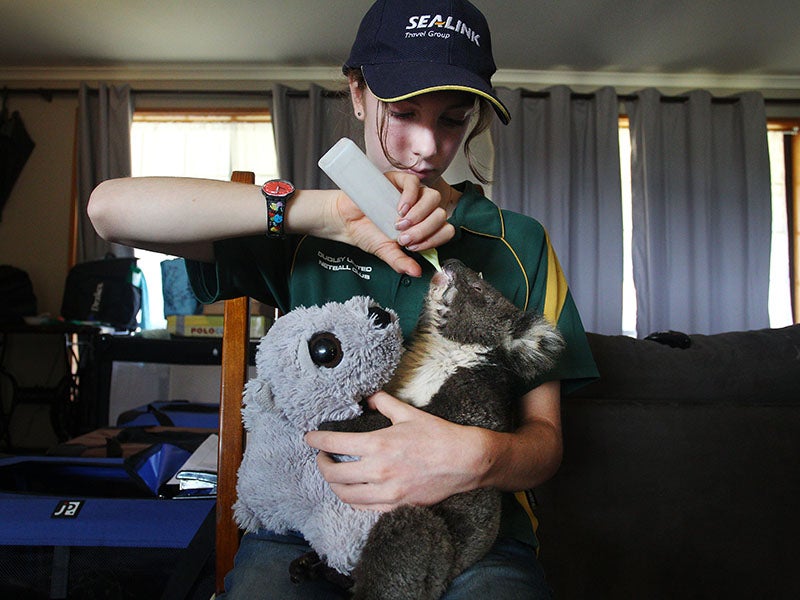Australia Is on Fire and Its Government Is Blowing Smoke
Attorney Noni Austin explains how the Australian prime minister says the country is doing its fair share to combat the climate crisis — but Australia is now the world’s No. 1 exporter of both coal and gas.
At least 25 people dead, 20 million acres burned, and a billion native animals killed. These are the devastating impacts of wildfires in Australia early in the southern hemisphere summer.
Australians are focused on the efforts to save communities and animals now — and they are talking about the climate crisis that’s at the root of the catastrophe. Prime Minister Scott Morrison continues to claim that Australia is doing its fair share to reduce its greenhouse gas emissions. But this is not true.
For a nation of only 25 million people, Australia’s contributions to the climate crisis are oversized — and it is on these emissions that the Australian battle to protect the climate will focus in 2020.
To start, Australia is among the world’s highest emitters of greenhouse gases per person and generates the vast majority of its energy from fossil fuels, with the current government committing to extending the lifespan of aging coal plants and proposing to develop new plants. All this in a land of abundant sun and wind resources.
Australia’s emissions continue to rise, and the country is unlikely to meet its emissions reductions targets under the Paris Agreement — targets which have, in any event, been widely criticized as far below Australia’s fair share. Instead, the government is relying on a carbon accounting loophole to carry over historic credits to claim it will meet its Paris targets.
Where Australia really stands out, however, is the sheer volume of fossil fuels it exports. Australia is the world’s largest exporter of coal, and has recently overtaken Qatar to become the largest exporter of gas. In fact, Australia exports 1.1 billion metric tons of carbon dioxide equivalent each year.
Australia remains determined to maintain and expand its fossil fuel exports by opening massive new coal and gas basins. For example, six coal mega-mines have been approved in the Galilee Basin in Queensland, one of the world’s largest untapped coal reserves estimated to contain over 23 billion metric tons of recoverable coal.
The annual emissions attributable to just one of these mines — the Carmichael mine — would be greater than the annual emissions of a number of countries, including Australia, Sri Lanka, and Malaysia.
These mines also threaten the cultural heritage of Indigenous tribes and would clear vast swathes of native vegetation habitat, consume huge volumes of water in a region plagued by drought, and contribute to the industrial shipping of coal through the threatened Great Barrier Reef.
Australia is also developing new gas fields, such as the Betaloo Basin in the Northern Territory where thousands of wells are proposed to be fracked, unleashing a greenhouse gas bomb and threatening water supplies for communities and ecosystems. The government and industry claim gas is a “bridge” fuel, ignoring the industry’s major methane emissions that supercharge the climate crisis.
And in something that would not be out of place in a Monty Python skit, Australia now exports much of its gas to Asian markets, resulting in domestic gas shortages. The government and industry are pushing to develop new sources of gas, as well as import terminals to reimport gas, to combat these shortages — all while being the world’s largest gas exporter.
Australia now faces a decision point. Last year was Australia’s hottest and driest year on record, with vast areas crippled by drought. For the past two decades, scientists have warned us that climate change would drive hotter weather, longer and more frequent heatwaves, and less rain, increasing the risk of wildfires in Australia. This year, these conditions created the dry vegetation and soil now fueling the firestorm sweeping the continent.
For many Australians, the time has come to change course on the climate crisis, and people and organizations are working tirelessly across the country to force the government to step up and protect our future. Earthjustice is proud to be helping Indigenous communities in Australia to challenge coal mining projects proposed on their ancestral lands and protect their human rights, advocating for the World Heritage Committee to call on Australia to curb carbon emissions to protect iconic places such as the Great Barrier Reef, and assisting organizations to fight back against fossil fuel production and export.
Looking to donate to help Australians affected by the fires? Consider giving to the Fire Relief Fund For First Nations Communities, an Indigenous-led effort to support people displaced by the wildfires. The Australian Conservation Foundation is also maintaining a list of organizations accepting donations for on-the-ground relief efforts.
The International Program partners with organizations and communities around the world to establish, strengthen, and enforce national and international legal protections for the environment and public health.
